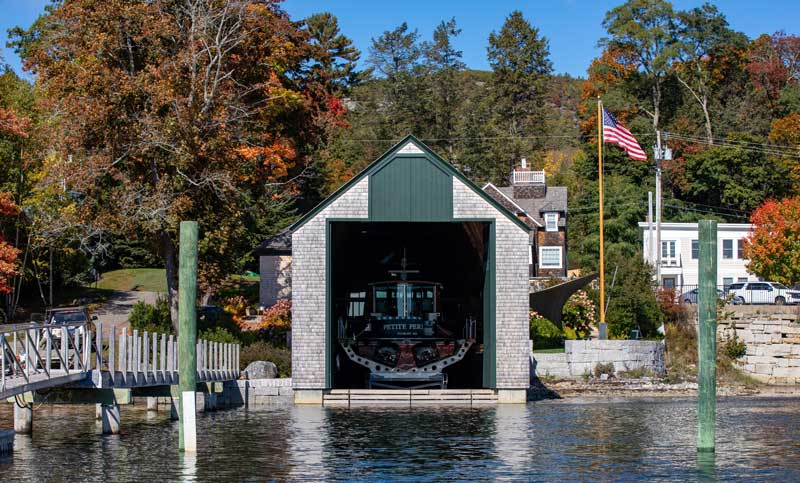Back in the early days, the up-hill, road-side space held a huge winch, pulleys, and cogs that controlled the marine railway. In the first few years the power was supplied by a team of mules or oxen, and later by a small donkey engine, Mohr said. The imprecise nature of the animals’ pulling is the reason for the addition of the bumper to the first Mona Loa’s bowsprit during hauling, he said, explaining: “So if they overpulled, it wouldn’t damage the bow of the boat.”
The 10-foot radius path the animals wore in the wooden floor while circling the capstan was still there when the new owners bought the building. While much of the original equipment didn’t fit in the new building and the flooring could not be saved, the owners preserved the original winch system, installing it in a special display case in the living quarters.
The new boat-hauling system is an engineering tour de force. “The owners said they wanted to be able to push a button and have the doors open and the boat slide into the water,” said Putnam. “While the stakes are slightly higher, it’s the same simple concept that my father and I used to launch our 1972 Whaler in our boathouse at the lake. We used a stick welder and a pop-level, but at this scale we needed to coordinate with lots of smart people to ensure mechanical, electrical, and structural components performed predictably so these owners could feel as though they were simply loading a Whaler.”
The system includes an aluminum boat cradle, specially designed to hold the owners’ 48-foot Hinckley. It sits on a 50' by 18' steel rail car that weighs about 7 tons, according to Samir Gupta, manager of Lyman-Morse Technologies division. The technologies division designed and built the custom boat cradle, the rail car that holds it, the electric capstan that hauls the boat, and all the controllers that make the system work safely, as well as new doors and a system to operate them.
Prock Marine designed and built the new marine railway, and installed the new cement footings and walls and the rails that extend out into the harbor.
The cradle and rail car are moved by a continuous chain-loop system connected to an electric capstan winch. The doors, boat cradle, and rail car can be operated from small hand-held remotes the size of garage door openers.
When the owners launch the boat, they climb on board from a small platform connected to the cradle, and operate the system from the boat. The chain slowly rotates with a certain amount of squeaks and clanks, lowering the boat and its cradle down the marine railway’s five-degree incline until it reaches two tall wooden poles in the water outside that mark the end, and the boat floats free. The system works similarly when the boat returns. The owners drive it onto the cradle, noting markers on the poles and cradle that let them know when the boat is set correctly, and then pushing a button to move it back inside. The water is deep enough to launch at about half-tide and higher. Should the tide not be right, the boathouse also has an adjacent dock with room for the 48-foot Hinckley and other boats.
While the 10-by-20-foot wooden doors facing the harbor look the same as they have for years, complete with the American Boathouse lettering, appearances can be deceptive.
The old wooden doors have been replaced with new ones made from fiberglass wrapped around a foam core and veneered with mahogany.
At the push of a button, steel arms silently fold the big doors back against the interior walls to open the boat bay. Another button closes them. Below the waterline another set of stainless steel grids veneered in oak allows water to flow in and out, but blocks floating debris. Bubblers installed under the basin keep the water from freezing in the winter.
The complex project took more than two years to complete, but the owners and all the people who helped make it happen are pleased with the results. And the rebuilt American Boathouse is ready for the next 100 years.
“I felt really honored to be involved with a project of this importance, as did every else,” said Fischer.
Polly Saltonstall is editor of this magazine.










